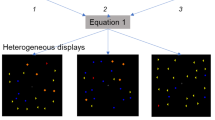Abstract
The surface area of human primary visual cortex (V1) varies substantially between individuals for unknown reasons. We found that this variability was strongly and negatively correlated with the magnitude of two common visual illusions, where two physically identical objects appear different in size as a result of their context. Because such illusions dissociate conscious perception from physical stimulation, our findings indicate that the surface area of V1 predicts variability in conscious experience.


Similar content being viewed by others
References
Dougherty, R.F. et al. J. Vis. 3, 586–598 (2003).
Frith, C., Perry, R. & Lumer, E. Trends Cogn. Sci. 3, 105–114 (1999).
Sereno, M.I. et al. Science 268, 889–893 (1995).
Gilbert, C.D. & Wiesel, T.N. J. Neurosci. 9, 2432–2442 (1989).
Bosking, W.H., Zhang, Y., Schofield, B. & Fitzpatrick, D. J. Neurosci. 17, 2112–2127 (1997).
Murray, S.O., Boyaci, H. & Kersten, D. Nat. Neurosci. 9, 429–434 (2006).
Fang, F., Boyaci, H., Kersten, D. & Murray, S.O. Curr. Biol. 18, 1707–1712 (2008).
Duncan, R.O. & Boynton, G.M. Neuron 38, 659–671 (2003).
Edden, R.A.E., Muthukumaraswamy, S.D., Freeman, T.C.A. & Singh, K.D. J. Neurosci. 29, 15721–15726 (2009).
Adams, D.L., Sincich, L.C. & Horton, J.C. J. Neurosci. 27, 10391–10403 (2007).
Dakin, S. & Frith, U. Neuron 48, 497–507 (2005).
de Fockert, J., Davidoff, J., Fagot, J., Parron, C. & Goldstein, J. J. Exp. Psychol. Hum. Percept. Perform. 33, 738–742 (2007).
Massaro, D.W. & Anderson, N.H. J. Exp. Psychol. 89, 147–151 (1971).
Fisher, G.H. Nature 215, 553–554 (1967).
Acknowledgements
We thank F. Sengpiel for comments on the manuscript. This work was supported by the Wellcome Trust.
Author information
Authors and Affiliations
Contributions
D.S.S. conducted the functional magnetic resonance imaging experiment and analyzed the data. C.S. conducted the behavioral experiment. D.S.S., C.S. and G.R. wrote the paper.
Corresponding author
Ethics declarations
Competing interests
The authors declare no competing financial interests.
Supplementary information
Supplementary Text and Figures
Supplementary Figures 1–3, Table 1 and Results (PDF 741 kb)
Rights and permissions
About this article
Cite this article
Schwarzkopf, D., Song, C. & Rees, G. The surface area of human V1 predicts the subjective experience of object size. Nat Neurosci 14, 28–30 (2011). https://doi.org/10.1038/nn.2706
Received:
Accepted:
Published:
Issue Date:
DOI: https://doi.org/10.1038/nn.2706
- Springer Nature America, Inc.
This article is cited by
-
Well-being is associated with cortical thickness network topology of human brain
Behavioral and Brain Functions (2023)
-
Behavioral examination of the role of the primary visual cortex in the perceived size representation
Scientific Reports (2023)
-
Comparing retinotopic maps of children and adults reveals a late-stage change in how V1 samples the visual field
Nature Communications (2023)
-
Linking individual differences in human primary visual cortex to contrast sensitivity around the visual field
Nature Communications (2022)
-
Mental imagery can generate and regulate acquired differential fear conditioned reactivity
Scientific Reports (2022)





